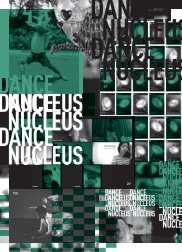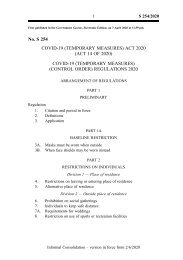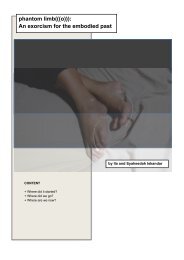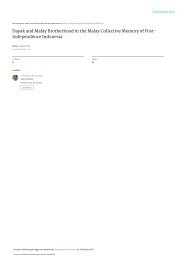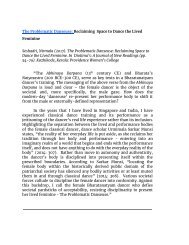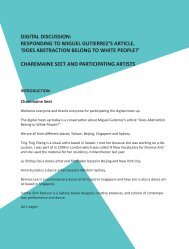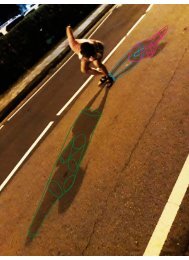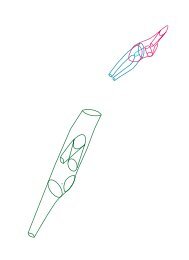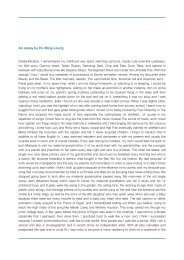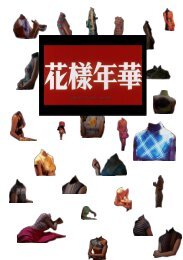Speculative Futures for Tactility Studies
You also want an ePaper? Increase the reach of your titles
YUMPU automatically turns print PDFs into web optimized ePapers that Google loves.
<strong>Speculative</strong> futures <strong>for</strong> <strong>Tactility</strong> <strong>Studies</strong><br />
by Shawn (in black) and Bernice (in purple)<br />
It is March 2021, a full year since all per<strong>for</strong>mances have been suspended. Live per<strong>for</strong>mance<br />
spaces remain shuttered but museums and galleries have since been reopened. <strong>Tactility</strong><br />
<strong>Studies</strong> has been commissioned as an installation at National Gallery Singapore.<br />
1) Devise <strong>Tactility</strong> <strong>Studies</strong> as an installation with no per<strong>for</strong>mers. Describe how audiences will<br />
experience this work. (How many people will experience it at a time? How will their<br />
encounter be facilitated? What is the protocol <strong>for</strong> maintaining the work after each<br />
encounter?)<br />
Shawn, Gua Khee, Corrie, and I, have been digging into the trajectory of <strong>Tactility</strong><br />
<strong>Studies</strong> during this strange time -- it feels to me like it’s been a time of rest,<br />
upheaval, busy-ness, and aimlessness. It’s hard to think about touch literacy in the<br />
original context of the work (touch as pleasure, touch as affection, touch as safety,<br />
oxytocin, weird, transgressive, traumatic, painful, experimental, evocative) when all<br />
kinds of touch today feel potentially life-threatening.<br />
(This morning, I saw a video of two children -- cousins -- hugging <strong>for</strong> the first time in<br />
months, and sobbing their hearts out. The other day, I visited my grandma <strong>for</strong> the<br />
first time in months, and the first thing she did was reach <strong>for</strong> a hug. My grandma<br />
isn’t really a huge hugger. I normally offer the hugs be<strong>for</strong>e I leave, and it’s a fairly<br />
new habit. She seemed more frail and tired than normal, but she wanted that hug.<br />
That hug made me think about how I need to ration my presence around others. I<br />
haven’t been out much at all, but even then that hug felt good, but also like it could<br />
be poison. I don’t think this feeling is going to go away <strong>for</strong> a long, long while,<br />
pending a vaccine. To feel more safe about those hugs, our brief visits, I decided I<br />
would steer clear of all other social visits as far as I could help it. Odd to ration a<br />
social life in terms of these risk analyses, but I suppose human touch and a sense of<br />
security do have a measurable relationship.)<br />
I don’t care about live per<strong>for</strong>mance if it means people die. But if death also comes<br />
with isolation and loneliness, perhaps the focus of this new speculative per<strong>for</strong>mance<br />
would shift in that direction. It would not be <strong>Tactility</strong> <strong>Studies</strong> the way it was created,<br />
at least not until we are truly sure that people can touch again, without prophylactic<br />
nor fear.<br />
This installation would probably need to be called something else. Since it’s not<br />
living in quite the same frame. Touch Artefacts? Touch Artefacture? <strong>Tactility</strong><br />
Artfactory?<br />
My first instinct was that we would use screens, or videos, something that captures<br />
the sense of touch through the visual. We could rely on objects, and then either gift<br />
them to the viewer, or wash/wipe them. But I think if the museum wanted this, we
would need to be able to use the fact of shared space, and the fact of ‘liveness’<br />
living on, in a place <strong>for</strong> objects and artefacts. So I’m going to go with my second<br />
instinct, which is to steer clear of screens, have people keep their electronic devices<br />
outside, and keep the focus on what we can do about touch through visuals,<br />
objects, sound, and other environmental manipulations.<br />
These are the steps I imagine taking, <strong>for</strong> creating the parameters of this (new)<br />
per<strong>for</strong>mance piece:<br />
1. Request a large-ish space, able to be divided using transparent curtains. One<br />
per<strong>for</strong>mer needs to be present, <strong>for</strong> 4-5 audience members at a time.<br />
2. The audience removes their shoes outside, and each follow a path of<br />
textures to their allocated spots. Not sure yet if blindfolds are used.<br />
3. Each person steps into a cubicle of space, each with 5m x 5m of space, each<br />
able to see the others.<br />
4. (If budgets allow) In each space, a large human-sized object, each made of a<br />
different material. The materials should evoke textiles in the home, mixed<br />
together differently. For example, aluminium foil mixed with Airism mesh;<br />
paper mixed with microfleece. To be discussed with visual collaborators. To<br />
be thoroughly washed/sanitised be<strong>for</strong>e every new group of audiences,<br />
depending on materials chosen.<br />
(If budgets don’t allow) Each audience member would have been asked to<br />
bring two things from home -- something they like to hug, and something<br />
they quite like to touch.<br />
5. The per<strong>for</strong>mance will take the audience through a range of sensations --<br />
bodily and emotional -- and seek to open bodies up to the vulnerability in<br />
purely body-to-body, wordless, narrative-free, connection. I won’t go into the<br />
details of movement choreography in this, but we’d be paying attention to<br />
ways that people start to interact with the space, the objects, and each other.<br />
The per<strong>for</strong>mer would have rehearsed multiple ways of composing, balancing,<br />
touching, squishing, giving weight to, and moving in the space around their<br />
objects. The audience will be invited to have their own tactile<br />
experimentations, within the boundaries of good hygiene and safety, and<br />
these ideas may inspire the per<strong>for</strong>mer and other audiences as well.<br />
Audiences will each receive notice about what those are be<strong>for</strong>e arriving at<br />
their scheduled per<strong>for</strong>mance time. Translations will be provided if needed.<br />
6. The per<strong>for</strong>mance will conclude with the Conversation Piece, in which we<br />
facilitate a discussion about the experience the audience went through as<br />
individuals, and as a group. Questions, complaints, revelations, ponderances<br />
-- all welcome.<br />
7. Given that the work is likely to feel extra raw, or hit extra raw nerves at this<br />
time, we will plan <strong>for</strong> additional conversation time after the Conversation<br />
Piece, during which conversations may also be non-verbal. Some audience<br />
members may favour sitting quietly in the space, perhaps laying on the floor,<br />
touching an object as a self-soothing mechanism, and so on.<br />
8. In this work, we are allowed to be like babies, curious about our sensations.
2 months later in May 2021, we are allowed to experience shows again, but it’s been too<br />
long since we have encountered one another in theatres, black boxes and even rehearsal<br />
studios. A new policy has been implemented, restricting per<strong>for</strong>mers from having any direct<br />
physical contact with audiences, and there must be a 1m radius around each audience<br />
member.<br />
2) Write an advisory notice to your participants, bearing in mind that this will be the first<br />
time most of them will be entering/participating in a live per<strong>for</strong>mance after a long hiatus.<br />
How will you assist with rehabilitating their experience in this notice?<br />
Dear friends and strangers,<br />
We’ve missed you. We’ve missed being together to experience something. We’ve<br />
missed being in the theatre.<br />
We don’t know what this will be like. We don’t know if we will be overwhelmed with<br />
emotion, or if we will be able to keep our personal feelings separate from our<br />
professional ones. Maybe we won’t want to keep our feelings separate. What are<br />
our professional feelings <strong>for</strong>, if not <strong>for</strong> feeling together and making sense together<br />
through a time like this?<br />
Thank you <strong>for</strong> coming out to be with us. Thank you <strong>for</strong> taking the chance that it<br />
could be overwhelming. Or that it could be underwhelming. We don’t know how our<br />
capacities <strong>for</strong> being in groups and sharing physical space have changed. We don’t<br />
know how our capacities <strong>for</strong> sitting in a soup of other people’s emotions and smells<br />
and hormones has shifted our experience of live per<strong>for</strong>mance. Please pay attention<br />
to your feelings as much as you can, and let your feelings be. Please leave at any<br />
point if you feel the need to. Or cry. Or laugh uncontrollably. It will be okay with us,<br />
and we will do our best to help you be okay also. We will also have people on<br />
standby, and a breakout room, should you need to chat and decompress at any<br />
time.<br />
<strong>Tactility</strong> <strong>Studies</strong> has always been firstly a study of the body, and of bodies together,<br />
through the sense of touch. We play with the sensitisation and attunement of bodies<br />
-- of people -- together in space. We have never been therapists, even if we think<br />
there might be therapeutic outcomes in a work like ours. But we will be here with<br />
you in figuring out what it is we are going through. Thank you <strong>for</strong> trusting us with<br />
your time and <strong>for</strong> coming out to experience this work. We don’t think of our<br />
per<strong>for</strong>mance as group therapy; but sometimes it might feel that way, and we are<br />
glad <strong>for</strong> it.<br />
With hugs,<br />
(everyone’s names)<br />
The <strong>Tactility</strong> <strong>Studies</strong> Team<br />
3) Where will this per<strong>for</strong>mance be held? Draw a layout of how the audience, and per<strong>for</strong>mers<br />
will be organised, and how their movements be choreographed.
See above. Will probably stick to only 1 per<strong>for</strong>mer with a rotating schedule as<br />
per<strong>for</strong>mers likely would still not be touching, or able to rehearse <strong>for</strong> extensive<br />
periods of time.<br />
4) Audience numbers are extremely limited. Who do you choose to prioritise? What do you<br />
put in place to ensure that the per<strong>for</strong>mance is accessible* <strong>for</strong> them? *Accessibility in meant<br />
here in an expanded sense, whether in terms of infrastructural needs, immunocompromised<br />
status, age and ability, flexibility of time etc.<br />
Depending on the budget, we could per<strong>for</strong>m this over a few days with a team of<br />
per<strong>for</strong>mers taking turns. The schedule would allow <strong>for</strong> a mix of demographics, while<br />
specific invitations can be made out to groups.<br />
While the elderly, especially those who live alone, would be a priority, we would also<br />
more likely want to visit them where they are than to bring them to NGS. This is<br />
something we would discuss with the curatorial team.<br />
I imagine that young working adults, especially those without children, would be<br />
most starved of touch during this time. They would be my priority. If my assumption<br />
is not true, and there is no such audience urgently seeking a per<strong>for</strong>mance like<br />
<strong>Tactility</strong> <strong>Studies</strong>, then they would not be my priority.<br />
We should also have a more specific discussion about the experiences that migrant<br />
workers living in dorms have been through, and/or that <strong>for</strong>eign domestic workers<br />
have been through, in this time -- and ways that this per<strong>for</strong>mance could speak to<br />
their lives, and its relationship to other workers’ lives. We could work with migrant<br />
workers who have been making art and per<strong>for</strong>ming in Singapore all along. We may<br />
also choose to focus the per<strong>for</strong>mance <strong>for</strong> survivors of family violence, and the<br />
people who have had to move into crisis shelters.<br />
5) Describe an object that the audience interacts with. How does this object become a<br />
proxy <strong>for</strong> touching one another? Alternatively, describe how the participants touch one<br />
another/per<strong>for</strong>mers across these distances.<br />
See above.<br />
6) You are a bored audience member, and somehow feeling detached from the<br />
per<strong>for</strong>mance. What is going through your mind, and what do you do? Does this resolve<br />
over the per<strong>for</strong>mance, or is this boredom acknowledged or facilitated somehow?<br />
I’d like not to speculate on what might happen in any individual’s mind! But I hope<br />
that they pass through boredom, and amusement, and joy, and awkwardness, and<br />
all other manner of feelings that they might go through, and that we would<br />
acknowledge and appreciate all of these feelings as they happen, and hold space<br />
<strong>for</strong> them. If this person chooses to talk about their emotional journey after the<br />
per<strong>for</strong>mance, I would love to listen also, and accept it as part of that temporal
landscape. And if the person wanted to try experiencing the work again, I would<br />
also appreciate that.<br />
In June 2021, you restage the work, but this time you managed to acquire a special license<br />
that permits touching to occur in the work (not more than 5 minutes across the entire<br />
per<strong>for</strong>mance).<br />
7) This is the first time a participant will be ‘touched’ in any per<strong>for</strong>mance since March 2020.<br />
Describe sequence of motions leading up to this moment of ‘touching’, and how will it<br />
manifest? How is this space held?<br />
The per<strong>for</strong>mer would need to read the participant’s responses on the spot, but<br />
generally speaking, touch would begin very minimally, perhaps with only eye<br />
contact and maintaining a close distance without touching, connecting through the<br />
air and gesture. In ‘<strong>Tactility</strong> <strong>Studies</strong>’, we also use objects and sound to introduce<br />
touch, and never assume that someone would be com<strong>for</strong>table or would remain<br />
com<strong>for</strong>table. The original score has mechanisms <strong>for</strong> holding a safe space where<br />
consent - ongoing, enthused, consent - is key. This version of the work (or new<br />
work?) will follow that trajectory, with full attention paid to health and safety risks.<br />
8) The per<strong>for</strong>mance has ended. You are an audience member. What do you do after the<br />
show, and where do you go? What stayed with you from the per<strong>for</strong>mance?<br />
9) You receive an email from an audience member after the show, who had felt<br />
uncom<strong>for</strong>table at one point in the work. (This discom<strong>for</strong>t isn’t necessarily a complaint, but it<br />
could be). Write this email describing what made them feel uncom<strong>for</strong>table and why. As a<br />
bonus, you can draft a response to this email.<br />
(Leaving these unanswered <strong>for</strong> the reader to have more<br />
headspace <strong>for</strong> their own speculations)<br />
In July 2021, <strong>Tactility</strong> <strong>Studies</strong> tours to Croatia. Un<strong>for</strong>tunately, air travel is still prohibitive, so<br />
you decide to stage the per<strong>for</strong>mance remotely, with local Croatian per<strong>for</strong>mers.<br />
10) What are the 3 main points you’d emphasise to your international collaborators as they<br />
attempt to stage <strong>Tactility</strong> <strong>Studies</strong>? (You may also choose to describe the process of<br />
‘transmitting’/‘translating’ this work)<br />
At this point, here are some points:<br />
1. We practice over many days different ways of connecting through touch.<br />
2. We sensitise ourselves to the verbal and non-verbal responses of individuals.<br />
3. We pay attention to the whole audience, and notice what they might be<br />
paying attention to as a group.
We would also work closely with the Croatian team to not only work with per<strong>for</strong>mers<br />
but a dramaturg or director who can oversee the work. We would need to learn<br />
more about cultural specificities <strong>for</strong> touch, consent, body language, and group<br />
gatherings.




